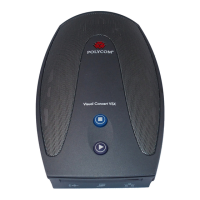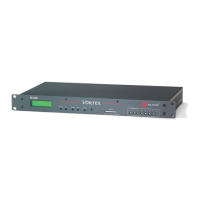Chapter 3 - System Commands
© Polycom, Inc. 3 - 79
spidnum spidnum <set|get> <“bchannel”>
spidnum set <“bchannel”>
[“number”]
spidnum get <“bchannel”|all>
Where:
• set: Sets the SPID number for a B
channel line when followed by the
“number” parameter. To erase the
current setting, omit “number”.
• get: Returns the current SPID
number associated with a B channel
of a particular line.
• “bchannel”: The line and B
channel. Valid values are:
1b1BRI line 1, B channel 1
1b2BRI line 1, B channel 2
2b1BRI line 2, B channel 1
2b2BRI line 2, B channel 2
3b1BRI line 3, B channel 1
3b2BRI line 3, B channel 2
4b1BRI line 4, B channel 1
4b2BRI line 4, B channel 2
• “number”: Numeric string. SPID
numbers are generally provided by
your network service provider.
•all: Returns SPIDs for all channels
of all lines.
Sets the ISDN SPID numbers
assigned to the BRI lines used
by the VSX system. SPIDs
generally apply only in the
United States and Canada. If
you are behind an internal
phone system (PBX), SPIDs
may not be required.
spidnum set 1b1
5125551212
st st <normal|inverted|get>
Where:
• normal: Sets the signal to normal
(falling edge sends data).
• inverted: Sets the signal to inverted
(rising edge sends data).
• get: Returns the current setting for
this option (normal or inverted).
Sets or gets the st serial
interface control signal (send
timing: clock) to normal or
inverted. The default setting is
“normal”.
User interface screen location:
System > Admin Settings >
Network >
V.35/RS-449/RS-530 (page 3):
ST
st get
v35dialingpr
otocol
v35dialingprotocol <rs366|get>
Where:
• rs366: Enables RS-366 as the
dialing protocol. At this time, RS-366
is the only supported dialing
protocol on the system.
•get: Returns the current setting.
Selects the dialing protocol.
Selecting a dialing protocol is
not needed if you are using your
DCE to dial the call or if you
have a dedicated connection to
the far site.
v35dialingprotoco
l rs366
Command Syntax Description Example

